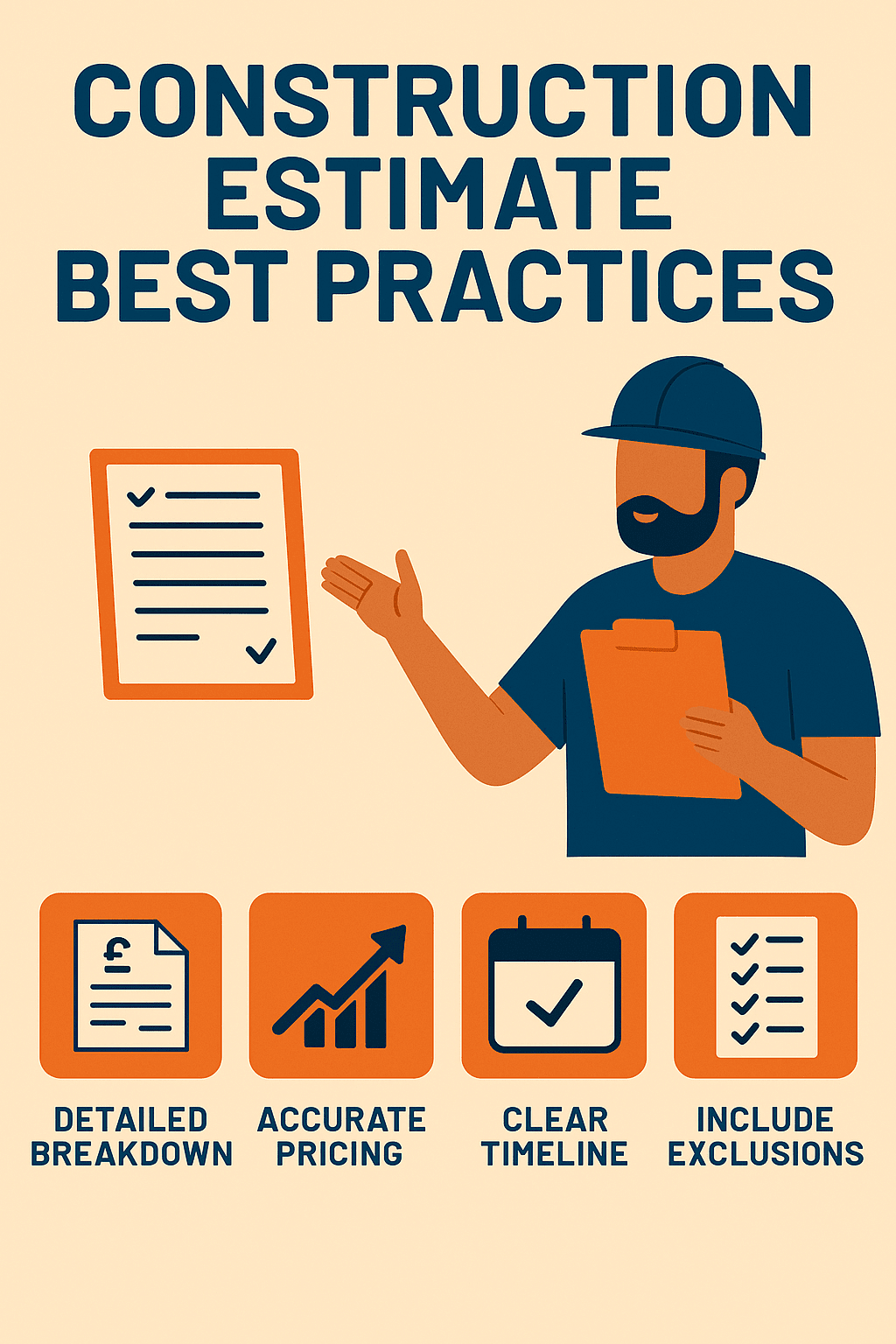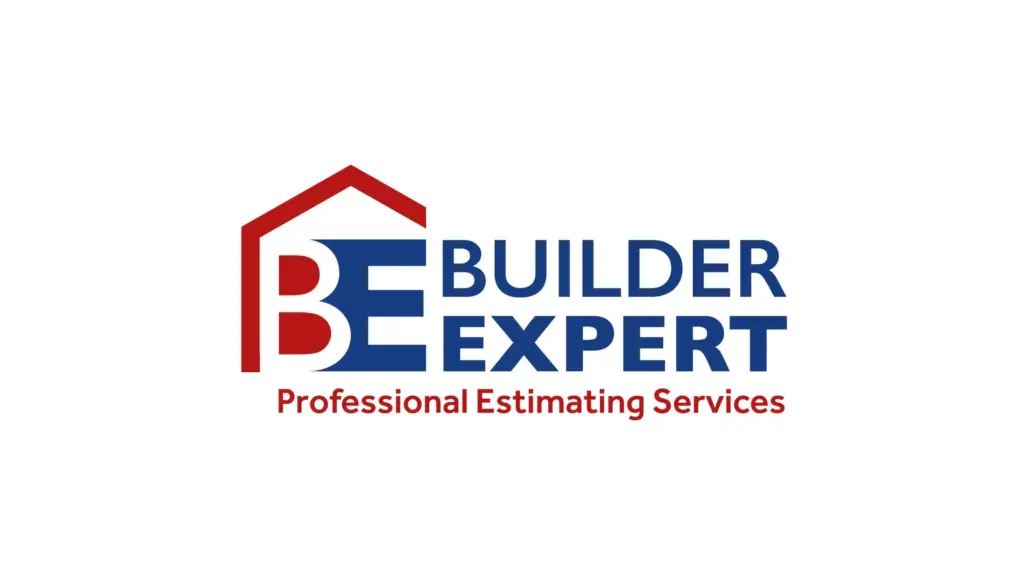In the UK building industry, a strong estimate is more than just a number — it’s the foundation of every successful project. Yet too often, estimations are rushed, oversimplified, or based on outdated methods. This leads to disputes, delays, and lost profits — especially in a volatile market where labour costs, material prices, and regulatory standards can shift rapidly.
That’s where construction estimate best practices come in. Whether you’re pricing a small residential renovation or a multi-million-pound commercial build, applying the right approach to estimating can mean the difference between a profitable project and a financial disaster.

In this comprehensive guide, we’ll break down the core principles, tools, and methods that define construction estimate best practices in the UK. You’ll learn how to:
✅ Avoid common mistakes that lead to budget overruns
✅ Use technology to streamline your estimates and increase accuracy
✅ Set realistic margins, track scope changes, and keep clients informed
✅ Build trust with clear, professional proposals
✅ Leverage detailed estimate templates like those from BuilderExpert
This isn’t just theory. We’ll link to real tools, templates, and guidance from BuilderExpert and trusted UK construction authorities to help you implement these practices immediately.
Whether you’re a seasoned builder, an estimator looking to sharpen your skills, or a construction company owner scaling operations, mastering construction estimate best practices will help you win more bids, control costs, and deliver better outcomes for your clients.
1. The Importance of Accuracy in Estimating
At the heart of construction estimate best practices lies one essential principle: accuracy is everything. A project can only succeed if the financial assumptions that underpin it are reliable. Inaccurate estimates not only damage your bottom line — they can also harm client relationships and your company’s reputation.
Why Accuracy Matters
An underpriced estimate might win you the job, but it could also mean:
- Reduced or negative profit margins
- Cash flow crises mid-project
- Disputes or legal issues with clients over “unexpected” costs
- A tarnished brand image and fewer referrals
Conversely, overestimating can price you out of competitive bids — especially in markets where homeowners and developers are closely comparing quotes.
That’s why the best UK builders use systematic approaches and professional tools to prepare their estimates. They combine experience with up-to-date supplier data, detailed quantity takeoffs, and intelligent cost forecasting.
Tools That Help You Stay Accurate
Thanks to modern technology, there’s no reason to rely on guesswork. Tools like BuilderExpert’s Construction Estimating Software allow you to:
- Generate detailed cost breakdowns in minutes
- Use real-time pricing from suppliers (see our article on real-time construction pricing)
- Adjust profit margins and version costs with transparency
- Create professional proposals for clients (see example estimates)
These platforms also integrate with project planning tools, enabling a smoother transition from estimate to site.
Common Pitfalls to Avoid
If you’re not following construction estimate best practices, you’re likely falling into one or more of these traps:
- Using outdated unit prices
- Copy-pasting from past jobs without adjusting for scale or complexity
- Ignoring lead times and availability for materials
- Failing to account for subcontractor price fluctuations
- Omitting overheads and indirect costs like scaffolding, waste disposal, or site insurance
Each of these oversights can compound into thousands of pounds lost.
2. Breaking Down the Components of a Construction Estimate
A professional estimate isn’t just a single figure — it’s a detailed breakdown of everything needed to complete the project. Knowing what to include (and how to structure it) is a key part of following construction estimate best practices.
Core Components of a Solid Estimate
Here’s what every UK builder should include:
📦 Materials
- Itemised lists with quantities, unit prices, and suppliers
- Adjusted for potential wastage (typically 5–10% depending on the material)
- Include delivery charges, storage, and handling costs
🔗 Learn how our estimating tool helps track and update real-time material prices
👷 Labour
- Clear breakdown by trade: bricklaying, roofing, electrics, etc.
- Labour rates based on regional standards or actual subcontractor quotes
- Account for site supervision, project management, and admin support
See our Construction Estimate Tasks Breakdown for more insight on how to structure labour tasks.
🏗️ Plant and Equipment
- Crane hire, scaffolding, diggers, skip hire, etc.
- Include delivery/setup and removal charges
- Consider whether hire duration is flexible (to avoid overpaying for downtime)
💸 Overheads and Profit
- Overheads: insurance, admin, health & safety compliance, site security
- Profit margin: typically ranges from 10–20%
- Many builders now show this transparently to clients using versioned estimates
🔗 Learn about Profit per Version — a BuilderExpert feature that ensures transparency and control.
🧾 Contingency
- Set aside 5–10% of the total cost for unforeseen issues
- Especially important for renovations or builds on challenging sites
📑 Preliminaries and Professional Fees
- Surveying, architect fees, structural engineers
- Building control and planning application fees
- Site setup (welfare, signage, fencing)
Use a Bill of Quantities (BoQ) Where Appropriate
For larger or more complex builds, a BoQ (Bill of Quantities) offers a formal, standardized way to detail the work, often required in tender processes. BoQs support accurate quoting and help clients compare offers more fairly.
🔗 Read more about how a Bill of Quantity supports estimate accuracy
3. How to Price Accurately in a Changing Market
One of the most important construction estimate best practices is staying adaptable. The UK construction market is volatile — material prices fluctuate, subcontractor availability shifts, and regulatory changes can quickly impact costs. To maintain profitability and credibility, builders must develop strategies that balance accuracy with flexibility.
📈 Track Real-Time Material Prices
Static pricing models are a thing of the past. In modern estimating:
- Use live pricing feeds from suppliers wherever possible
- Review historic trends to forecast potential spikes
- Always build in a price validity window for your quotes (e.g., “valid for 30 days”)
🔗 Our Real-Time Pricing Software integrates directly with supplier data, helping you stay ahead of the curve.
📊 Account for Labour Market Trends
With a national labour shortage, UK builders face rising trade rates. Ensure you:
- Update your labour rates quarterly
- Get multiple subcontractor quotes per trade
- Include availability timelines in your estimate (delays can cost more than price changes)
💰 Adjust for Regional Variations
Labour and materials can cost 20–40% more in London than in the North West. Following construction estimate best practices means tailoring every estimate to the local context.
Use location-specific data to refine your figures — BuilderExpert lets you filter by region, project type, and property size.
📦 Lock in Supplier Terms When You Can
If a supplier offers to fix pricing for 60–90 days, consider negotiating bulk purchase agreements or setting delivery windows in advance. This protects both your estimate and your margin.
⚠️ Don’t Forget Inflation and Market Risks
Especially for longer-term projects (6+ months), inflation must be factored in. Add a cost escalation clause to your contracts, and communicate this clearly to your client.
🔗 BuilderExpert’s estimate versioning lets you show how pricing changes over time — useful for transparency and client communication.
4. Transparency and Client Communication in Estimating
One of the core construction estimate best practices is maintaining clear and transparent communication with your clients. No matter how accurate your numbers are, if the client doesn’t understand them — or doesn’t trust them — problems are bound to follow.
📄 Break Down the Estimate, Line by Line
Don’t send a lump sum and hope for the best. A proper construction estimate best practice is to provide a full breakdown, including:
- Labour costs for each trade (e.g. plumbing, roofing, joinery)
- Material quantities and unit prices, updated to reflect current supplier rates
- Plant and equipment costs, especially if you’re hiring heavy machinery
- Profit margins and overheads, so the client sees your markup is fair
- Any provisional sums or prime cost items
This kind of breakdown is a hallmark of construction estimate best practices — it reduces confusion, manages expectations, and creates trust.
🔗 Use BuilderExpert’s Detailed Estimate format to generate estimates that look professional and clear.
💬 Define Scope, Exclusions, and Conditions
Clarity about what’s included and what’s excluded is essential. One of the most common causes of disputes is unclear scope — a problem easily solved by applying construction estimate best practices.
Be sure to:
- List all inclusions (tasks, finishes, materials, warranties)
- Specify exclusions (e.g. planning application fees, utility connections)
- Clarify site conditions or assumptions
- Mention any items subject to survey or third-party approval
These steps are not just helpful — they’re vital elements of construction estimate best practices that help protect you legally.
📆 Set Timelines and Estimate Validity Period
Another one of the overlooked construction estimate best practices is setting a validity period. In today’s volatile pricing environment, you must state how long the estimate remains valid (usually 30–60 days).
Also, give an indicative project start date and timeline — this helps clients plan and adds urgency to accept your quote.
💡 Educate the Client (Without Overwhelming Them)
A huge part of construction estimate best practices is helping the client feel comfortable with the numbers. Many homeowners don’t realise the cost of scaffolding, insurance, or site security.
Take a moment to briefly explain key cost areas — this positions you as transparent and trustworthy.
💬 You can also direct clients to BuilderExpert’s Construction Estimate Example to give them a real-world frame of reference.
🧾 Document Everything and Create an Audit Trail
Don’t rely on verbal conversations. One of the most protective construction estimate best practices is putting everything in writing. Send formal PDF estimates, record every revision, and get digital sign-offs.
This creates an audit trail that can save you thousands in disputes.
🔗 BuilderExpert also offers Bill of Quantity tools to back up your estimates with official documentation — another smart way to apply construction estimate best practices.
5. Legal and Contractual Alignment: Turning the Estimate Into a Contract
Once the estimate is accepted, the next vital step is turning it into a legally binding agreement. This stage is where construction estimate best practices move from pricing into protection. Too many builders skip this step or rely on informal agreements — and when problems arise, they’re left exposed.
📜 Use Clear, Written Contracts
One of the foundational construction estimate best practices is to pair your accepted estimate with a formal contract. This can be a JCT Minor Works Contract (common in the UK), a custom-written agreement, or a BuilderExpert-generated contract template.
Your contract should include:
- Client and builder details
- The scope of work, directly tied to the estimate
- Total contract value and payment schedule
- Start and completion dates
- Clauses for variations, delays, disputes, and termination
If the estimate is detailed and the contract aligns with it, you’ve followed construction estimate best practices for legal protection.
🔗 You can find useful contract templates and advice on Citizens Advice.
💰 Align Payment Schedules With Project Milestones
A key part of legal clarity — and smart construction estimate best practices — is tying payments to clear milestones:
- 10% deposit on contract signing
- 30% after groundwork
- 30% after shell complete
- 20% after interior fit-out
- 10% on practical completion
This structure protects both builder and client. It ensures cash flow for the builder while giving the client confidence they’re not overpaying early.
🔗 Read our full guide on Construction Payment Schedules for best practices and sample schedules.
🛠️ Include Variation and Contingency Clauses
No matter how accurate your estimate, changes will happen. That’s why construction estimate best practices include preparing for variations. Your contract should:
- Define how variations are requested and approved
- Specify whether they’re costed by day rate, material mark-up, or quoted separately
- Include a contingency clause (typically 5–10%) for unexpected events
This protects your margins — and your relationship with the client.
🏛️ Stay Legally Compliant With UK Law
Part of adhering to construction estimate best practices is understanding your legal responsibilities:
- Provide cooling-off periods for domestic contracts
- Hold proper insurances (public liability, employer’s liability)
- Comply with CDM regulations for safety and design risks
- Register for CIS (Construction Industry Scheme) if applicable
These aren’t just best practices — they’re legal necessities that help you operate professionally.
🧾 Real-World Tip: Match Contract to Estimate Exactly
One of the most overlooked construction estimate best practices is ensuring that your estimate becomes Schedule A of your contract — word-for-word. This avoids disputes about “what was agreed” later.
🧠 Pro tip: Store all documents — contracts, estimates, drawings — in a shared cloud folder with access for all stakeholders. This centralises communication and shows you follow industry-best processes.
6. Project Planning and Scheduling: Aligning Time, Cost, and Scope
Once contracts are signed, it’s time to move from numbers to action. Proper planning is one of the most underrated construction estimate best practices, yet it determines whether your project stays on track — or spirals into delays and disputes.
🗓️ Create a Detailed Construction Schedule
A solid project schedule is more than a Gantt chart. It should be a living document that connects tasks, deadlines, costs, and resource allocation. Aligning this with your estimate ensures budget accuracy from day one.
Break your project into key phases:
- Groundworks
- Substructure
- Superstructure
- Envelope
- Internal works
- Finishes and handover
Then break these into task-level activities with dependencies and timelines.
🔗 See our Construction Estimate Tasks Breakdown to understand how to tie your tasks directly to your estimate.
Construction estimate best practices suggest using project management software (like BuilderExpert, Procore, or Monday.com) that allows real-time updates and sharing between site and office.
🔄 Sync Planning With Procurement
Your schedule must align with materials and subcontractor availability. A big reason estimates fall apart is because timelines assume ideal conditions — while suppliers are backlogged or labour is unavailable.
A few tips to ensure construction estimate best practices:
- Confirm lead times on all critical materials (e.g. windows, steel, HVAC units)
- Line up subcontractors before confirming start dates
- Build in buffers for weather, inspections, or design changes
📘 The Federation of Master Builders (FMB) recommends a minimum 10% float on major items — especially during high-demand seasons. Learn more.
🧠 Integrate Cost Tracking With Planning
Planning is not just about when tasks happen — but how much they’ll cost at each stage. Construction estimate best practices involve connecting your schedule with your cost breakdown:
- Assign budgeted cost to each task or phase
- Track actual spend vs budgeted at least weekly
- Use software to flag overruns early
This is where real-time estimating platforms shine. BuilderExpert’s tools let you track changes, adjust scope, and reforecast budget impact in seconds.
🔗 Learn how real-time construction estimating software prevents budget surprises.
👷 Coordinate with Your Team
Your crew needs to know the plan, too. Regular team briefings — backed by printed or app-based task lists — are essential. The best construction teams:
- Hold daily toolbox talks
- Share weekly lookahead schedules
- Use mobile apps to track task status
Construction estimate best practices aren’t just about finance — they’re about communication, too.
🧰 Tools like BuilderExpert let you assign, track, and adjust tasks tied directly to your original estimate, bridging the gap between office and site.
🔚 Summary: Why Construction Estimate Best Practices Matter
In today’s competitive and fast-moving building industry, construction estimate best practices are not optional — they are essential. A good estimate sets the tone for the entire project, affecting contracts, schedules, procurement, and final profitability.
From the initial scoping to the final handover, your estimate needs to be accurate, detailed, and flexible enough to handle change. It must reflect real-time prices, account for labour trends, and comply with UK regulations. Using modern tools like BuilderExpert’s Construction Estimating Software is one of the smartest moves you can make to streamline this process and reduce risk.
By adopting construction estimate best practices, you will:
- Reduce costly errors and omissions
- Avoid underbidding and protect your margins
- Improve communication across teams
- Deliver projects on time and on budget
- Earn client trust and build your reputation
Don’t let outdated methods cost you time and money. Whether you’re a small local builder or managing multi-million-pound developments, the principles of effective estimating remain the same — clarity, accuracy, consistency, and adaptability.
🔗 For a full overview of how BuilderExpert helps UK builders create professional, flexible estimates, see our Detailed Construction Estimate page.
In the end, the builders who embrace these best practices — and the technology that supports them — will be the ones who succeed, grow, and stay ahead in an increasingly competitive market.

